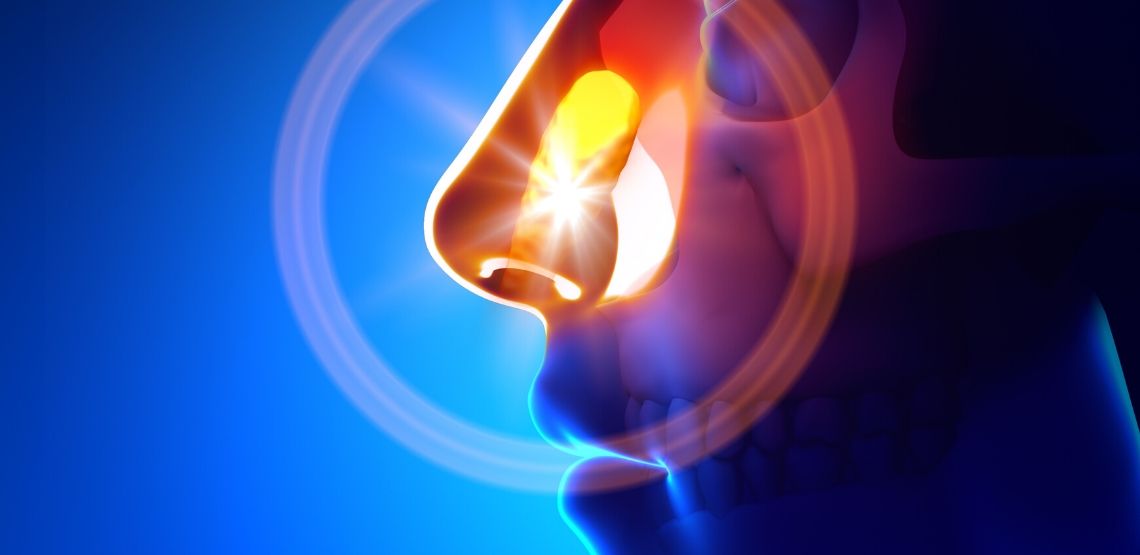How to Tell if You Have Nasal Polyps
Nasal polyps are benign growths that develop in the lining of the nose. Nasal polyps symptoms can include an obstructed nasal passage if they become too big, potentially causing complications such as infections, breathing difficulties and a loss of smell. To help, consider XOLAIR (omalizumab), used to treat chronic rhinosinusitis with nasal polyps (CRSwNP) in adults.
10 Uncommon Signs of Nasal Polyps
- Loss of smell (anosmia).
- Frequent nosebleeds.
- Snoring and sleep disturbances.
- Chronic mouth breathing.
- Facial pressure or pain.
- Persistent postnasal drip.
- Headaches, especially in the forehead.
- Recurrent sinus infections.
- Itchy eyes or watery eyes.
- Nasal congestion that doesn't respond to typical treatments.
What Are Nasal Polyps?
Nasal polyps are soft, painless, fleshy growths that develop in the lining (mucosa) of the nose. They may be yellow-brown, grayish or pink in color, with a teardrop shape. They may grow in one or both nostrils (either singly or in clusters).
The polyps themselves are harmless and, if they are small in size, don’t cause any symptoms. Many people with nasal polyps don’t even know they have them! However, if the polyps grow too big, they can block the nasal passages and cause chronic congestion. This can lead to breathing problems, discomfort and even a loss of smell if left untreated.
What Causes Nasal Polyps?
Nasal polyps are associated with chronic inflammation of the mucosa — in other words, long-term irritation and swelling of the lining of the nasal cavities. As a result, they are most often seen in people with persistent asthma, cystic fibrosis, aspirin-exacerbated respiratory disease (AERD) and chronic rhinosinusitis (CRS). Recurrent infections, aspirin sensitivity, allergies and foreign objects that become lodged in the nose are also factors that can increase the risk of developing nasal polyps. Though they can affect anyone, they are far more common in adults than children.
What Are the Different Symptoms of Nasal Polyps?
Nasal polyps are soft and painless, so they usually don’t cause any symptoms when small. As they start to grow, however, they can block the nasal cavities and cause chronic congestion, leading to symptoms such as:
- A persistently blocked or stuffy sensation in the nose.
- Difficulty breathing through the nose.
- A runny nose.
- Postnasal drip (this is where mucus runs down the back of the throat).
- A feeling of pressure and/or pain in the forehead and/or face.
- Pain in the upper teeth.
- Reduced or lost sense of taste.
- Reduced or lost sense of smell.
- Frequent nosebleeds.
- Snoring.
Related Search Topics (Ads)
Who Is Most at Risk of Getting Nasal Polyps?
Anyone can get nasal polyps, but they are usually associated with chronic inflammation. Therefore, the people most at risk of developing nasal polyps are:
- People with asthma.
- People with allergies to aspirin and other nonsteroidal anti-inflammatory drugs (NSAIDs), such as ibuprofen.
- People with chronic pollen allergies (AKA chronic rhinitis).
- People with chronic rhinosinusitis (CRS).
- People with cystic fibrosis.
Nasal polyps usually affect adults. However, they are also common in children with cystic fibrosis.
How Are Nasal Polyps Diagnosed?
If you think you may have nasal polyps, you should go and see a — especially if you are experiencing difficulty breathing or a reduced sense of smell. Nasal polyps are diagnosed with a simple visual exam, in which the doctor will look inside your nose.
Treatment Options for Nasal Polyps
The symptoms caused by nasal polyps cannot be addressed until the polyps are removed. The first line of treatment usually involves medication, in which topical medications are sprayed into the nose to shrink the polyps. If this does not work, surgery may be necessary to remove the polyps.
Medication Treatment for Nasal Polyps
Often, the first treatment option for nasal polyps is topical medication. These are usually steroids (such as fluticasone, budesonide or mometasone), which can be sprayed or dropped into the nose to shrink the polyps. If successful, this type of treatment can significantly reduce the size of the polyps and alleviate congestion as a result.
In cases where the nasal drops or sprays don’t work, or if your nasal polyps are advanced and large, your doctor may recommend steroid tablets instead.
You can also consider XOLAIR, a medicine used to help with allergies and asthma. It works by stopping certain chemicals in your body that cause allergic reactions. If you have asthma or allergies that don’t get better with other treatments, XOLAIR might help you feel better.
Surgical Treatment for Nasal Polyps
Nasal polyps that don’t respond to medications may require surgery to fix. The surgical techniques most commonly used to address nasal polyps are polypectomy and endoscopic sinus surgery.
Polypectomy
During a polypectomy, a surgical instrument called a microdebrider is used to carefully cut away the nasal polyps. This is a minor surgery and is usually performed as an outpatient procedure.
Endoscopic Sinus Surgery
If your polyps are large, the doctor may recommend endoscopic sinus surgery in place of a polypectomy. This is the most common treatment option for nasal polyps and involves the insertion of an endoscope (a thin, flexible instrument with a tiny camera and tools on the end) into the nose. This can then be used to cut and remove polyps and any other obstructions in the nasal cavities; like the polypectomy, this is usually an outpatient surgery.
Potential Complications of Surgery to Remove Nasal Polyps
In many cases, surgery significantly improves the symptoms of people with nasal polyps. Unfortunately, recurrence is common, and nasal polyps have been found to grow back 18 months after endoscopic sinus surgery in around 40% of cases. Other possible side effects from the surgery include:
- Nosebleeds.
- Infections.
Top Foods with Anti-inflammatory Properties
Several foods possess anti-inflammatory properties. Here are some examples:
- Ginger: Ginger contains gingerol, a substance known for its anti-inflammatory properties. It can be used in various dishes, teas, or consumed as a supplement.
- Turmeric: Curcumin, the active compound in turmeric, has powerful anti-inflammatory properties. It can be used in curries, smoothies or taken as a supplement.
- Berries: Blueberries, strawberries, raspberries and blackberries are rich in antioxidants and flavonoids, which can help reduce inflammation.
- Fatty fish: Salmon, mackerel, sardines and trout are high in omega-3 fatty acids, which have potent anti-inflammatory effects.
- Leafy greens: Spinach, kale, collard greens and Swiss chard are packed with antioxidants and phytochemicals that combat inflammation.
Foods That Worsen Nasal Congestion
Certain foods can potentially worsen nasal congestion in some individuals. Here are some examples:
- Dairy products: Dairy foods like milk, cheese and ice cream can thicken mucus and promote congestion in some people. This is not the case for everyone, but it's worth monitoring your reaction to dairy if you experience nasal congestion.
- Processed foods: Highly processed foods often contain additives, preservatives and artificial ingredients that can trigger inflammation and congestion in sensitive individuals.
- Fried and fatty foods: Foods high in unhealthy fats, such as fast food, fried foods and greasy snacks, can promote inflammation and congestion.
- Sugary foods and drinks: High-sugar foods and beverages can cause inflammation and worsen congestion in some individuals. Sugary drinks like soda and sweetened juices can be particularly problematic.
- Spicy foods: Spicy foods can irritate the nasal passages and trigger some people's congestion or runny nose. This varies from person to person, so observing your response is important.
The Worst Triggers for Nasal Congestion
Nasal congestion, also known as a stuffy or blocked nose, can be caused by various factors. While triggers can vary from person to person, here are some common culprits known to worsen nasal congestion:
- Allergens: Allergic reactions to substances such as pollen, dust mites, pet dander, mold, or certain foods can lead to nasal congestion. These allergens can cause inflammation in the nasal passages, resulting in congestion.
- Irritants: Exposure to irritants like cigarette smoke, strong odors, air pollution, chemicals, or cleaning products can irritate the nasal passages and trigger congestion.
- Respiratory infections: Common colds, flu, sinus infections and other respiratory infections can cause nasal congestion as a symptom. Viral or bacterial infections can lead to inflammation and increased mucus production, leading to a stuffy nose.
- Weather changes: Cold weather, dry air, or sudden changes in temperature and humidity levels can affect the nasal passages. Dry air can dry out the nasal membranes, leading to congestion.
- Certain foods: Spicy foods, hot peppers and foods that cause histamine release in some individuals (such as aged cheese, alcohol, fermented foods and processed meats) can trigger nasal congestion in susceptible people.
The 5 Worst Cities to Live in With Sinuses
- Phoenix, Arizona: Phoenix is known for its hot and dry climate, which can cause dehydration and dry out nasal passages, leading to sinus discomfort.
- Houston, Texas: Houston has high humidity levels, which can contribute to mold growth, dust mites and other allergens, triggering sinus problems for susceptible individuals.
- New Orleans, Louisiana: The humid subtropical climate of New Orleans, combined with its proximity to marshy areas, can create a conducive environment for mold and other allergens that can irritate sinuses.
- Las Vegas, Nevada: Las Vegas is situated in the desert and experiences extremely dry air. The lack of humidity can dry out nasal passages, potentially causing sinus issues for some individuals.
- Pittsburgh, Pennsylvania: Pittsburgh has been ranked among the cities with the highest levels of air pollution in the US. Poor air quality can aggravate sinus conditions and respiratory problems for some people.
Make Sure You Stay Hydrated
Drinking an adequate amount of water can help alleviate nasal congestion and promote overall sinus health. Here's how water can be beneficial for nasal congestion:
- Hydration: Drinking enough water throughout the day helps maintain proper hydration levels, which helps keep the nasal passages moist. Well-hydrated nasal passages are less likely to become dry and congested.
- Thinning mucus: When you're well-hydrated, the mucus in your nasal passages becomes thinner and easier to expel. Thinner mucus allows for improved nasal drainage and helps relieve congestion.
In Conclusion
Nasal polyps are a common condition that affects up to 4% of people worldwide, though they are usually associated with chronic inflammation. As a result, they are most frequently diagnosed in people with asthma, chronic rhinosinusitis, cystic fibrosis and aspirin-exacerbated respiratory disease (AERD). However, anyone can get nasal polyps, and learning how to recognize the symptoms as soon as they arise is key for quick and effective treatment.
Article Resources
- Medical News Today (All about nasal polyps)
- NCBI (Chapter 7: Nasal polyps.)
- WebMD (Who typically gets nasal polyps?)
- Mayo Clinic (Nasal polyps)
- Harvard Health Publishing (Nasal Polyps)
- NCBI (Paediatric nasal polyps in cystic fibrosis)
- NHS (Nasal polyps)
- NCBI (A review of nasal polyposis)
- Healthline (Nasal Polyps)
- Cleveland Clinic (Nasal Polyps: Management and Treatment)
- NCBI (Prevalence of polyp recurrence after endoscopic sinus surgery for chronic rhinosinusitis with nasal polyposis)

